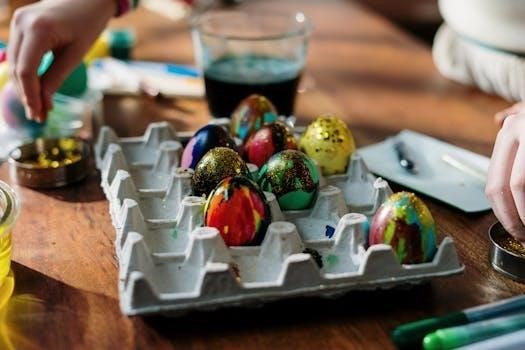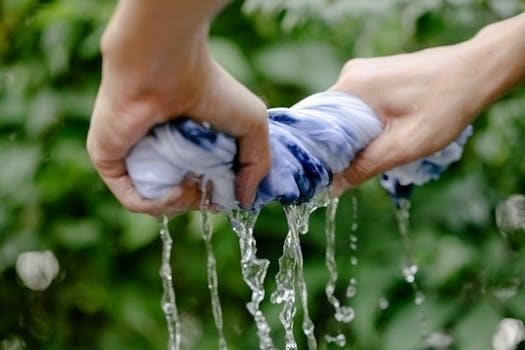
tie dye wash instructions printable

Follow these simple steps to ensure your vibrant tie-dye creations stay bright and beautiful after washing. Proper care is crucial for preserving the colors and patterns you’ve worked hard to create, ensuring long-lasting enjoyment of your unique garments.
Pre-Washing Fabric
Before you even think about applying dye, it’s essential to properly prepare your fabric. Pre-washing is a crucial step that often gets overlooked, but it significantly impacts the final results of your tie-dye project. New fabrics often contain sizing or finishes from the manufacturing process which can interfere with dye absorption. These substances create a barrier, preventing the dye from fully penetrating the fibers, leading to uneven color distribution and potentially faded or less vibrant results. Therefore, pre-washing removes any residue or impurities, making the fabric more receptive to the dye. For the best outcome, choose a gentle cycle with cold water, avoiding the use of fabric softeners or bleach, as these can also hinder dye uptake. Once washed, allow the fabric to air dry completely before moving to the next step of your tie-dye process. This simple pre-wash ensures the dye will adhere properly, resulting in a brighter, longer-lasting design on your chosen garment or fabric.
Setting the Dye
After applying your vibrant dyes, it’s crucial to allow ample time for the colors to properly set into the fabric. This crucial step, often referred to as batching, ensures that the dye molecules bond effectively with the fibers, resulting in a more lasting and less prone to fading. This process usually involves placing your freshly dyed items in a sealed plastic bag or container to maintain a moist environment. The ideal setting time varies, typically ranging from 6 to 8 hours, or even overnight, depending on the type of dye used and the desired intensity. Allowing for extended setting times is particularly useful for achieving deeper, more saturated colors. During this period, the dye penetrates the fabric, creating a strong bond that will withstand the washing process. This step is essential for preventing color bleeding and ensuring your tie-dye design remains vibrant for a long time. Once the setting period is complete, you can then move on to the rinsing stage.
Initial Rinse with Cold Water
Once the dye has set, the next crucial step is the initial rinse, and it must be done with cold water. This is essential for stopping the dye reaction and preventing the colors from bleeding into unwanted areas, especially the white parts of your design. Keeping the rubber bands or ties in place during this initial rinse helps to maintain the integrity of your tie-dye pattern. The cold water helps to flush out the loose, unabsorbed dye particles without further setting them into the fabric. It’s important to rinse your tie-dyed item under a steady stream of cold water, allowing the excess dye to flow away. This process may take some time, and you should continue rinsing until the water begins to run relatively clear. This initial cold water rinse is vital for preventing the colors from running during subsequent washing steps and for ensuring the vibrancy of your tie-dye project. Be patient and thorough during this step, as it significantly impacts the final outcome.

Rinsing Until Water Runs Clear
After the initial cold water rinse, it’s absolutely critical to continue rinsing your tie-dyed item until the water runs completely clear. This step ensures that all the excess, unabsorbed dye is removed from the fabric, preventing it from bleeding or staining other parts of your design or other garments during future washes. This process might require patience and persistence, as the water may initially be heavily tinted with the dye. You should continue to rinse under a gentle flow of cold water, manipulating the fabric to ensure all areas are thoroughly rinsed. It’s also a good idea to open up the fabric, if possible, to allow water to reach all the crevices and folds. This step is crucial in achieving crisp lines and vibrant colors in your tie-dye design. Don’t rush this step; the more thoroughly you rinse, the better the final result will be. Remember, clear water means all the loose dye has been washed away.

First Wash⁚ Alone in Cold Water
After thoroughly rinsing your tie-dyed item until the water runs clear, the next crucial step is its first wash. This initial wash should always be done separately from other garments to prevent any potential color bleeding. Place your tie-dyed item in the washing machine alone, without any other clothes. It’s essential to use cold water for this first wash. Hot water can cause the dye to run and fade, compromising the vibrancy of your design. Adding a small amount of mild detergent is acceptable, but avoid using harsh chemicals or bleach. Set your washing machine to a gentle or delicate cycle to minimize any stress on the fabric. This initial solo wash helps remove any remaining loose dye particles that might have been missed during rinsing, while also setting the dye further into the fabric. This is a critical step to ensure the longevity and vibrancy of your tie-dye project.
Using Mild Detergent
When washing your tie-dyed items, it is crucial to choose a mild detergent to protect the vibrant colors and the integrity of the fabric. Harsh detergents can strip the dye, causing it to fade prematurely or bleed into lighter areas. Opt for a gentle, color-safe detergent that is free from bleach and other harsh chemicals. Avoid using fabric softeners, as they can interfere with the dye’s absorption and lead to a dull appearance. A small amount of mild detergent is usually sufficient for washing tie-dyed items, especially during the first few washes. Using less detergent is better than using too much, as excess detergent can leave residue on the fabric. Remember that the primary goal is to remove any remaining loose dye without damaging the color. Always follow the recommended dosage on your detergent’s packaging and avoid using excessive amounts, ensuring your tie-dye stays vivid and beautiful for longer.
Avoiding Hot Water and Bleach
When washing tie-dyed items, it is imperative to avoid hot water and bleach, as these can significantly damage the colors and patterns. Hot water can cause the dye to bleed and fade, particularly during the first few washes, leading to a loss of vibrancy and clarity. Bleach, on the other hand, is a harsh chemical that can completely remove the dye from the fabric, resulting in a washed-out or uneven appearance. Always use cold water for washing tie-dyed items, as cold water helps to set the dye and prevent it from running. This is particularly important for the initial washes, where excess dye is more likely to be released. For subsequent washes, continue using cold water to preserve the color intensity. Furthermore, never use any detergents that contain bleach or use bleach alternatives, as these will also damage the dye. By consistently avoiding hot water and bleach, you will ensure that your tie-dye creations remain colorful and vibrant for a long time.

Drying Methods⁚ Air Dry vs. Low Heat
When it comes to drying your tie-dyed items, it’s crucial to choose the correct method to protect the vibrant colors and prevent shrinkage. Air drying is generally the gentlest option, allowing your tie-dye to dry naturally without exposure to excessive heat. This method is particularly recommended for delicate fabrics or items that are prone to shrinking. To air dry, simply hang your tie-dyed garments on a line or a drying rack, preferably out of direct sunlight, which can cause the colors to fade over time. If using a tumble dryer, always opt for a low-heat setting. High heat can damage the fabric and cause the dye to fade prematurely. Ensure that the dryer is set to a gentle cycle to minimize any friction that could lead to color loss. Check the care label on your garment for specific drying instructions, as some fabrics may be more susceptible to damage from heat than others. By taking care when drying, you will ensure your tie-dye remains vibrant for longer.
Subsequent Washes⁚ With Similar Colors
After the initial wash of your tie-dyed item, it’s important to continue washing it with similar colors to prevent any potential color bleeding or transfer. While the majority of the excess dye should be removed in the first wash, there’s still a possibility of some residual dye being released, especially during the first few washes. Washing your tie-dye with similar colors will safeguard your other clothes from getting stained. Sort your laundry carefully, grouping items with comparable shades, such as darks with darks and lights with lights. Avoid washing your newly tie-dyed garments with whites or light-colored clothes, as even minimal dye transfer can cause unwanted staining. It’s advisable to continue using cold water for subsequent washes to further minimize the risk of color fading or bleeding. By washing with like colors and using cold water, you can maintain the vibrancy of your tie-dye and prevent any unwanted color mishaps in your laundry routine.
Dealing with Excess Dye
Even with thorough rinsing, some excess dye may persist in your tie-dyed fabric. This excess dye can sometimes lead to slight color bleeding during washing or cause color transfer to other items. To address this, there are several effective methods you can employ; One of the most helpful techniques is to soak your tie-dye item in a solution of cold water and white vinegar for about 30 minutes before the first wash. The vinegar helps to set the dye and remove some of the excess. In addition to vinegar, you can also use a commercial color fixative product, which is specifically designed to prevent color bleeding; When washing the first time, consider adding a color-catching sheet to the washing machine; it will trap any loose dye. If you notice significant color bleeding after the initial wash, consider repeating the rinsing and soaking processes, before washing it again. By being proactive about dealing with excess dye, you can minimize the chances of color bleeding and maintain the vibrant appearance of your tie-dye project for a long time.